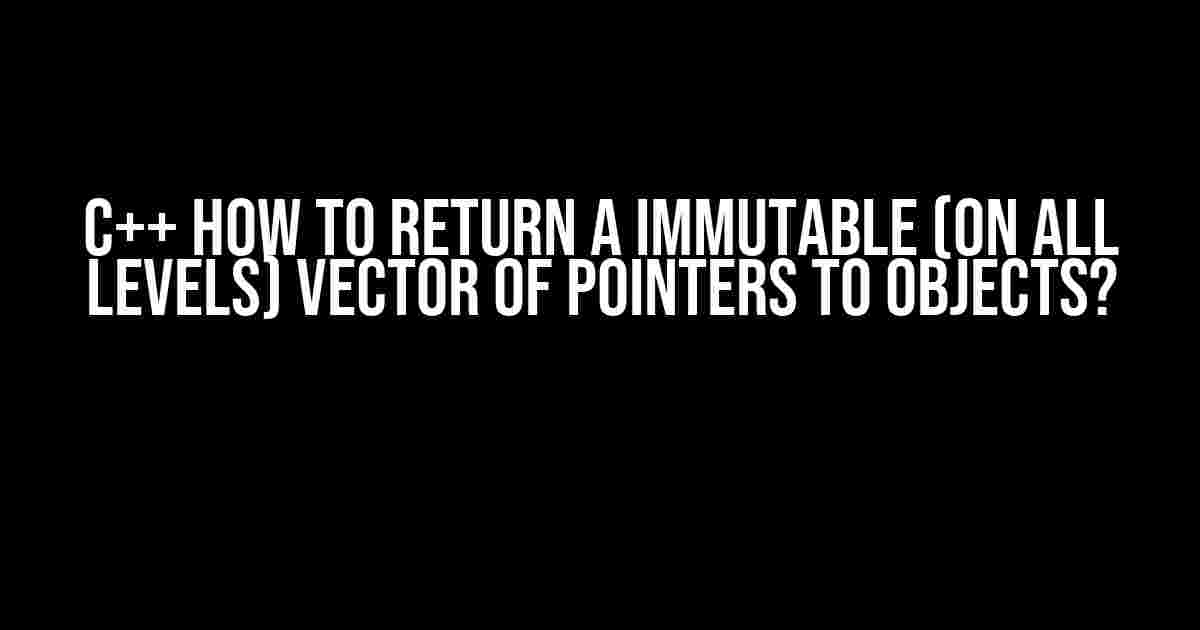Ah, the eternal conundrum of C++: how to return a vector of pointers to objects while ensuring immutability on all levels. It’s a puzzle that has stumped even the most seasoned developers. But fear not, dear programmer, for today we shall unravel the mystery and provide a comprehensive guide on how to achieve this feat.
The Importance of Immutability
Before we dive into the solution, let’s take a step back and understand why immutability is crucial in this context. When we return a vector of pointers to objects, we’re essentially handing over a collection of references to external entities. If these entities can be modified externally, it can lead to unpredictable behavior, data corruption, and even crashes. By ensuring immutability, we guarantee that the returned vector and its contents remain untouched, providing a stable and reliable API.
The Challenge of Immutability
So, why is achieving immutability on all levels so difficult? The main culprits are:
- Pointer mutability**: By definition, pointers can be modified to point to different objects or have their contents changed.
- Vector mutability**: Vectors themselves can be resized, sorted, or have elements inserted/deleted, affecting the contained pointers.
- Object mutability**: The objects being pointed to can be modified, either directly or indirectly, compromising the immutability of the entire structure.
The Solution: A Step-by-Step Guide
To overcome these challenges, we’ll employ a combination of clever programming techniques and robust C++ features. Follow along as we break down the solution into manageable chunks.
Step 1: Define an Immutable Object Class
class ImmutableObject {
public:
// constructor and other necessary methods
ImmutableObject() = default;
ImmutableObject(const ImmutableObject&) = delete; // no copying allowed
ImmutableObject& operator=(const ImmutableObject&) = delete; // no assignment allowed
// ...
};In this example, we define an `ImmutableObject` class that prohibits copying and assignment operations using deleted functions. This ensures that instances of this class cannot be modified or duplicated.
Step 2: Create a Vector of Immutable Objects
std::vector<const ImmutableObject*> vec;We declare a vector of pointers to `ImmutableObject` instances, using `const` to ensure the pointers themselves cannot be modified.
Step 3: Populate the Vector with Immutable Objects
ImmutableObject obj1, obj2, obj3;
vec.push_back(&obj1);
vec.push_back(&obj2);
vec.push_back(&obj3);We create instances of `ImmutableObject` and add their addresses to the vector. Since the objects are immutable, their contents cannot be changed.
Step 4: Return an Immutable Vector
std::vector<const ImmutableObject*>& getImmutableVector() {
std::vector<const ImmutableObject*> vecCopy = vec; // create a copy of the original vector
vecCopy.shrink_to_fit(); // remove excess capacity
return vecCopy;
}We create a copy of the original vector, ensuring that the returned vector is not connected to the original. We also use `shrink_to_fit()` to remove any excess capacity, preventing potential issues with resizing.
Additional Considerations
While we’ve achieved immutability on all levels, there are some important aspects to keep in mind:
- Lifetime management**: Ensure that the objects being pointed to outlive the returned vector, to avoid dangling pointers.
- Thread-safety**: If multiple threads access the returned vector, additional synchronization mechanisms may be necessary to prevent concurrent modifications.
- Copies and Assignments**: Be cautious when creating copies or assigning the returned vector, as this can lead to unintended mutations.
Conclusion
Returning an immutable vector of pointers to objects in C++ requires careful consideration and deliberate design. By following these steps and guidelines, you can create a robust and reliable API that ensures data integrity and stability. Remember, immutability is not just a virtue, it’s a necessity in modern software development.
| Keyword | Explanation |
|---|---|
| C++ | The programming language used to implement the solution. |
| Immutable | A state or object that cannot be modified once created. |
| Vector | A dynamic array data structure in C++. |
| Pointers | Variables that store memory addresses as their values. |
| Objects | Instances of classes or structs that encapsulate data and behavior. |
By mastering the art of immutability, you’ll unlock the full potential of C++ and create software that is robust, reliable, and maintainable. Happy coding!
Here is the HTML code with 5 Questions and Answers about “C++ How to return a immutable (on all levels) vector of pointers to objects?”:
Frequently Asked Question
Get the answers to your questions about returning an immutable vector of pointers to objects in C++.
How do I return a vector of pointers to objects in C++?
To return a vector of pointers to objects in C++, you can use the `vector` class template and specify the type of objects you want to store as pointers. For example: `std::vector myVector;`. You can then fill the vector with pointers to objects of type `ClassName` and return it from a function.
How can I make the vector itself immutable?
To make the vector itself immutable, you can use the `const` keyword when declaring the vector. For example: `const std::vector myVector;`. This will prevent the vector from being modified after it’s created.
How can I make the objects pointed to by the vector immutable?
To make the objects pointed to by the vector immutable, you can use the `const` keyword when declaring the objects and the pointers to them. For example: `const ClassName* objPtr;`. This will prevent the objects from being modified through the pointers.
How can I ensure that the vector and its contents are immutable at all levels?
To ensure that the vector and its contents are immutable at all levels, you can use a combination of `const` and `std::vector`. This will prevent the vector from being modified, and also prevent the objects pointed to by the vector from being modified through the pointers.
What are some best practices to follow when working with immutable vectors of pointers to objects in C++?
Some best practices to follow when working with immutable vectors of pointers to objects in C++ include using `const` correctness, avoiding raw pointers, using smart pointers instead, and encapsulating the vector and its contents within a class to ensure thread safety and data integrity.
Let me know if you’d like me to make any changes!
